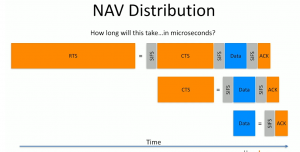The 802.11 standard ensures that all stations, both radio-based network interface cards (NICs) and access points, implement access methods for sharing the air medium. When installing wireless LANs (WLAN), most people don’t give much thought to these mechanisms. A solid understanding of 802.11’s medium access methods, however, will enable you to deal more effectively with issues such as radio frequency interference, denial of services attacks and throughput issues.
Distributed Coordination Function (DCF)
The 802.11 standard makes it mandatory that all stations implement the DCF, a form of carrier sense multiple access with collision avoidance (CSMA/CA). CSMA is a contention-based protocol making certain that all stations first sense the medium before transmitting. The main goal is to avoid having stations transmit at the same time, which results in collisions and corresponding retransmissions.

I will try to explain this process in simple words so layman can understand that how DCF functions in Wireless environment. I will break process in figure for better understanding.
There are 2 ways station make decision whether to start transmission or wait. If you look at chart start it says 2 things occurs constantly.
- Physical carrier sense
- Virtual Carrier Sense
- Physical carrier sense: Do we sense energy at lets suppose -62 dBm? Answer will be simple Yes or No. If Answer is yes station will go back to same process of sensing the physical medium and at the same time stations also involved in virtual carrier sense as well.
- Virtual carrier sense: In order to understand virtual carrier sense its also important to understand NAV (Network allocation vector) timer. NAV timer is the time which stations remember by listening to the RF transmission and remembering how long it will take for other station to complete its transmission. Station will store that time into its memory as in NAV timer and sooner transmission from other station is completed it will start decrementing its NAV timer. Once NAV timer reaches to Zero station has the opportunity to transmit.
Once NAV timer reaches to Zero, It will check the medium once again whether it sense any signal at lets suppose -82dBm. Answer will be again Yes or No. If yes station will add that transmission duration into its NAV timer. I have added diagram below to show how NAV timer will be calculated for example in RTS and CTS.

Sooner the Answer is NO for both question discussed above for both Energy Detect and Signal Detect we wait for DIFS
- DIFS is 34 microseconds in 5GHz OFDM
- After DIFS station randomly back off for period of time and then station has opportunity to transmit
- Station go through same process for each and every transmission.